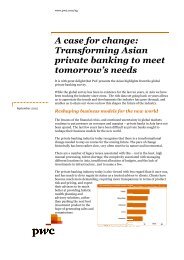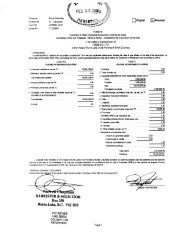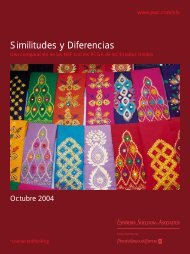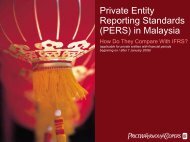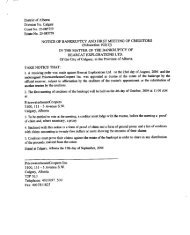TLS Newsletter 11 marzo 2011 - PwC
TLS Newsletter 11 marzo 2011 - PwC
TLS Newsletter 11 marzo 2011 - PwC
Create successful ePaper yourself
Turn your PDF publications into a flip-book with our unique Google optimized e-Paper software.
Secondo questo primo orientamento, la mancata indicazione<br />
di tutti gli elementi previsti dall’articolo 4, Legge n.<br />
223/1991 rende inefficace la procedura, in quanto tale<br />
omissione precluderebbe alle Organizzazioni Sindacali<br />
la possibilità di verificare la corrispondenza tra le ragioni<br />
dell’esubero di personale e le risorse da mettere in mobilità,<br />
determinando, così, l’inefficacia dei licenziamenti<br />
intimati.<br />
La sentenza in commento adotta, invece, un’interpretazione<br />
più flessibile della previsione normativa.<br />
In particolare, la Corte ha ritenuto che le motivazioni<br />
contenute nella lettera di avvio della procedura fossero<br />
coerenti con le ragione addotte dall’istituto di credito a<br />
fondamento della riduzione del personale, non circoscritta<br />
ad una singola unità produttiva ma estesa all’intero<br />
complesso aziendale, in quanto atta a pervenire ad<br />
una complessiva riduzione del costo del lavoro.<br />
Ad opinione della Corte, la legittimità del comportamento<br />
della Banca trova fondamento anche nel fatto che,<br />
nell’accordo di programma sottoscritto tra l’azienda ed<br />
i sindacati all’esito della procedura, il datore di lavoro<br />
si era impegnato ad attivare gli ammortizzatori sociali<br />
del settore (Fondo di solidarietà), adottando, altresì,<br />
un criterio formale per la determinazione degli esuberi<br />
(anzianità di servizio e contributiva).<br />
Per la Corte, “l’istituto di credito ha fornito alla parte<br />
sindacale le informazioni utili e necessarie per effettuare<br />
un serio controllo ed evitare così il pericolo di discriminazioni<br />
o personalizzazioni indebite nell'individuazione<br />
del personale da ritenere in esubero, sempre in<br />
considerazione della motivazione generale posta a base<br />
dello stesso (la necessità di procedere ad una riduzione<br />
del personale, interessante tutte le realtà aziendali sul<br />
territorio) e dello specifico, esclusivo criterio di scelta<br />
con il quale si è ritenuto di farvi fronte, quello appunto<br />
della maggiore anzianità lavorativa e contributiva dei<br />
dipendenti”.<br />
La pronuncia afferma, quindi, che, nel caso di procedure<br />
riguardanti l’intero comparto aziendale, il datore<br />
di lavoro non ha l’onere di specificazione delle aree di<br />
eccedenza e dei profili professionali in esubero, purché<br />
l’individuazione dei lavoratori coinvolti nel licenziamento<br />
collettivo segua un criterio selettivo oggettivo ed<br />
applicabile senza alcuna discrezionalità.<br />
According to this first approach, the non-disclosure of all<br />
elements of Article 4, Law No. 223/1991, causes the ineffectiveness<br />
of al procedure, because such an omission would<br />
prevent the Unions a chance to review the compliance of the<br />
reasons for the oversupply of personnel and resources to be<br />
made redundant, causing, thus, the ineffectiveness of the<br />
individual dismissals.<br />
The sentence under review has, however, provided for a<br />
more flexible interpretation of the statutory provisions.<br />
In particular, the Court considered that the reasons indicated<br />
in the letter initiating the procedure were consistent<br />
with the reasons given by the Bank for the reduction of<br />
staff, not confined to a single productive unit, but extended<br />
to the whole company, since it is likely to achieve an overall<br />
reduction in labor costs.<br />
In the opinion of the Court, the lawfulness of the conduct<br />
of the Bank is rooted in the fact that, for in the program<br />
signed between the company and the Trade Unions to the<br />
outcome of the procedure, the employer had undertaken to<br />
activate the social benefits (Solidarity Fund), taking also a<br />
formal criterion for determining the redundancy (length of<br />
service and paid contributions).<br />
For the Court, “the bank has provided to the Trade Unions<br />
the relevant information required to make a serious control<br />
and avoid the danger of undue discrimination or customization<br />
of the individual employees to be considered redundant,<br />
always in consideration of the general motivation indicated<br />
(the need to carry out staff reductions, affecting all<br />
companies in the area) and the specific, exclusive selection<br />
criterion by which it was decided to face the redundancies,<br />
that is length of service and paid contributions.”<br />
The ruling states, then, that in the case of proceedings<br />
concerning the entire business sector, the employer does not<br />
have the burden to specify areas and profiles to be considered<br />
redundant, provided that the selection of workers<br />
involved in the dismissal follow a collective and objective<br />
selection criterion, applicable without any discretion.<br />
<strong>TLS</strong> <strong>Newsletter</strong> n° 3 Anno 20<strong>11</strong> 24





